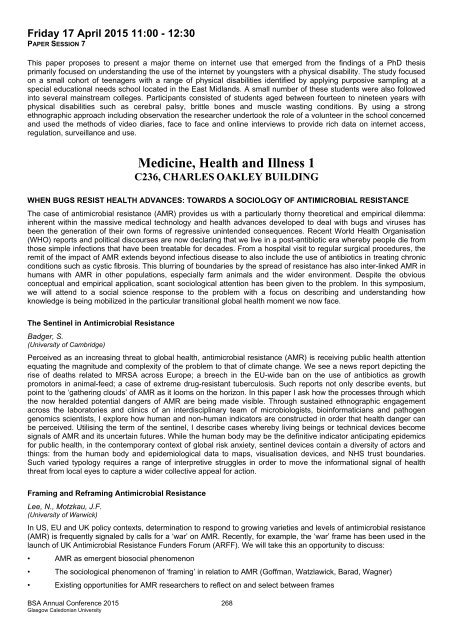Programme full
Programme full
Programme full
You also want an ePaper? Increase the reach of your titles
YUMPU automatically turns print PDFs into web optimized ePapers that Google loves.
Friday 17 April 2015 11:00 - 12:30<br />
PAPER SESSION 7<br />
This paper proposes to present a major theme on internet use that emerged from the findings of a PhD thesis<br />
primarily focused on understanding the use of the internet by youngsters with a physical disability. The study focused<br />
on a small cohort of teenagers with a range of physical disabilities identified by applying purposive sampling at a<br />
special educational needs school located in the East Midlands. A small number of these students were also followed<br />
into several mainstream colleges. Participants consisted of students aged between fourteen to nineteen years with<br />
physical disabilities such as cerebral palsy, brittle bones and muscle wasting conditions. By using a strong<br />
ethnographic approach including observation the researcher undertook the role of a volunteer in the school concerned<br />
and used the methods of video diaries, face to face and online interviews to provide rich data on internet access,<br />
regulation, surveillance and use.<br />
Medicine, Health and Illness 1<br />
C236, CHARLES OAKLEY BUILDING<br />
WHEN BUGS RESIST HEALTH ADVANCES: TOWARDS A SOCIOLOGY OF ANTIMICROBIAL RESISTANCE<br />
The case of antimicrobial resistance (AMR) provides us with a particularly thorny theoretical and empirical dilemma:<br />
inherent within the massive medical technology and health advances developed to deal with bugs and viruses has<br />
been the generation of their own forms of regressive unintended consequences. Recent World Health Organisation<br />
(WHO) reports and political discourses are now declaring that we live in a post-antibiotic era whereby people die from<br />
those simple infections that have been treatable for decades. From a hospital visit to regular surgical procedures, the<br />
remit of the impact of AMR extends beyond infectious disease to also include the use of antibiotics in treating chronic<br />
conditions such as cystic fibrosis. This blurring of boundaries by the spread of resistance has also inter-linked AMR in<br />
humans with AMR in other populations, especially farm animals and the wider environment. Despite the obvious<br />
conceptual and empirical application, scant sociological attention has been given to the problem. In this symposium,<br />
we will attend to a social science response to the problem with a focus on describing and understanding how<br />
knowledge is being mobilized in the particular transitional global health moment we now face.<br />
The Sentinel in Antimicrobial Resistance<br />
Badger, S.<br />
(University of Cambridge)<br />
Perceived as an increasing threat to global health, antimicrobial resistance (AMR) is receiving public health attention<br />
equating the magnitude and complexity of the problem to that of climate change. We see a news report depicting the<br />
rise of deaths related to MRSA across Europe; a breech in the EU-wide ban on the use of antibiotics as growth<br />
promotors in animal-feed; a case of extreme drug-resistant tuberculosis. Such reports not only describe events, but<br />
point to the ‘gathering clouds’ of AMR as it looms on the horizon. In this paper I ask how the processes through which<br />
the now heralded potential dangers of AMR are being made visible. Through sustained ethnographic engagement<br />
across the laboratories and clinics of an interdisciplinary team of microbiologists, bioinformaticians and pathogen<br />
genomics scientists, I explore how human and non-human indicators are constructed in order that health danger can<br />
be perceived. Utilising the term of the sentinel, I describe cases whereby living beings or technical devices become<br />
signals of AMR and its uncertain futures. While the human body may be the definitive indicator anticipating epidemics<br />
for public health, in the contemporary context of global risk anxiety, sentinel devices contain a diversity of actors and<br />
things: from the human body and epidemiological data to maps, visualisation devices, and NHS trust boundaries.<br />
Such varied typology requires a range of interpretive struggles in order to move the informational signal of health<br />
threat from local eyes to capture a wider collective appeal for action.<br />
Framing and Reframing Antimicrobial Resistance<br />
Lee, N., Motzkau, J.F.<br />
(University of Warwick)<br />
In US, EU and UK policy contexts, determination to respond to growing varieties and levels of antimicrobial resistance<br />
(AMR) is frequently signaled by calls for a ‘war’ on AMR. Recently, for example, the ‘war’ frame has been used in the<br />
launch of UK Antimicrobial Resistance Funders Forum (ARFF). We will take this an opportunity to discuss:<br />
• AMR as emergent biosocial phenomenon<br />
• The sociological phenomenon of ‘framing’ in relation to AMR (Goffman, Watzlawick, Barad, Wagner)<br />
• Existing opportunities for AMR researchers to reflect on and select between frames<br />
BSA Annual Conference 2015 268<br />
Glasgow Caledonian University


